A number of studies conducted by staff working in the areas of language testing, second language acquisition, and psycholinguistics make use of eye-tracking as part of the methodology. Click here for student projects.
Staff projects
A longitudinal look at mental language and False Belief
- Who? Ditte Boeg Thomsen (Lancaster University, UK), Silke Brandt (Lancaster University, UK), Birsu Kandemirci (Lancaster University, UK), Anna Theakston (University of Manchester, UK)
- What? This eye-tracking study is part of a bigger project which aims to shed more light on the causal and temporal relationships between children’s language development and their understanding of others’ minds and beliefs. This so-called false-belief understanding can be measured explicitly (asking children direct test questions, such as “where will she look for the ball?”) or implicitly. In the implicit tests, children will watch a video where a character is also searching for an object. But instead of asking a direct test question, children are expected to just look towards the location where they expect the character to search for the object.
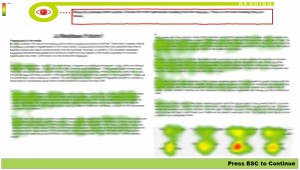 Looking into reading: Test-takers’ cognitive processing during reading test completion
Looking into reading: Test-takers’ cognitive processing during reading test completion
- Who? Tineke Brunfaut (Lancaster University, UK), Gareth McCray (Lancaster University, UK)
- What? This study examined test-takers’ cognitive processing whilst completing reading comprehension tasks. By means of a combination of eye-tracking and stimulated recalls, cognitive processing was investigated in general, and also depending on reading task type, test-takers’ ESL proficiency and their ESL reading proficiency. This project was externally funded by a British Council Aptis Assessment Research Grant 2013.
- Research Output
- Brunfaut, T. & McCray, G. (2015). Looking into test-takers’ cognitive processes whilst completing reading tasks: A mixed-methods eye-tracking and stimulated-recall study. ARAGs Research Reports Online, AR/2015/001. London: British Council.
- Brunfaut, T., & McCray, G. (2015, Sep). Cognitive processing during reading-test completion: Insights from eye tracking. Paper presented at the Task-Based Language Teaching (TBLT) conference, Leuven (Belgium).
- Brunfaut, T. (2015, Feb). How do English second language speakers complete reading test tasks? Insights from eye tracking and stimulated recalls. Invited paper presented at the Faculty of Education, University of Ljubljana (Slovenia).
- Brunfaut, T. & McCray, G. (2014, Nov). Looking into reading: The use of eye-tracking to investigate test-takers’ cognitive processing. Paper presented at the Language Testing Forum (LTF), Southampton (UK).
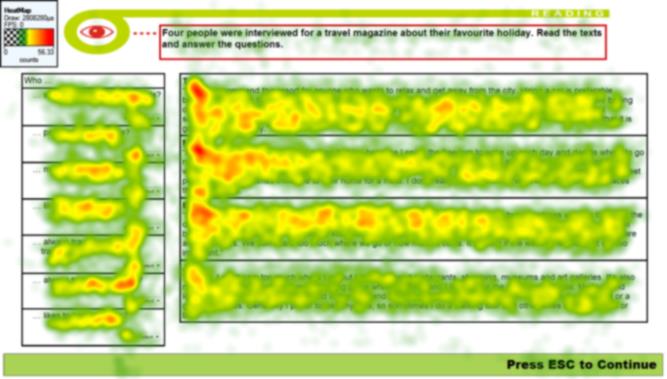 Looking into reading II: A follow-up study on test-takers’ cognitive processing during reading test completion
Looking into reading II: A follow-up study on test-takers’ cognitive processing during reading test completion
- Who? Tineke Brunfaut (Lancaster University, UK)
- What? This research was a follow-up study on the project ‘Looking into Reading’ (see above). On the basis of the first study’s findings and recommendations, additional research was conducted into test-takers’ cognitive processing while completing reading comprehension tasks. Cognitive processing was investigated through a combination of eye-tracking and stimulated recalls. The specific purpose of this follow-up study was to further inform test development and validation of the reading test under scrutiny. This project was externally funded by the British Council.
- Research Output
Modelling second language reading proficiency using eye-tracking measures
- Who? Tineke Brunfaut (Lancaster University, UK), Gareth McCray (Lancaster University, UK)
- What? This study aims to relate various measures derived from eye-tracking traces to second language learners’ reading ability. It uses mixture modelling and includes interactions between measures in the modelling process.
- Research output
Attentional processing of different types of written L2 input and its relationship with learners’ working memory capacity – an extension
- Who? Bimali Indrarathne (Lancaster University, UK), Judit Kormos (Lancaster University, UK)
- What? This is an extension of a study which examined how second language learners paid attention to novel grammatical constructions in a reading text presented under four different input conditions and how attention and the subsequent improvement in performance is related to participants’ working memory capacity. In this extension, we added a fifth input condition (i.e. feedback after each reading text) and are investigating whether feedback is influential in how learners pay attention to input and in subsequent learning gains.
- Research output
Investigating the integrated and independent TOEFL iBT writing tasks: Test-taker behaviors, underlying cognitive processes, and their relationships to text quality
- Who? Marije Michel (Lancaster University, UK), Andrea Révész (University College London, UK)
- What? In this project we investigate the cognitive validity of the independent and integrated TOEFL iBT writing tests using an innovative combination of eye-tracking, key-stroke logging and stimulated recall measuring test performances of L2 users of B1 to C1 CEFR language proficiency.
- Research output
- Michel, M., Révész, A., Lu, X., Kourtali, N. E., Lee, M., & Borges, L. (2020). Investigating L2 writing processes across independent and integrated tasks: A mixed-methods study. Second Language Research, 36(3), 307-334.
- Révész, A., & Michel, M. (2019). Methodological advances in investigating L2 writing processes. Studies in Second Language Acquisition, 41. Special Issue.
- Révész, A., & Michel, M. (2021, May). The relationship of proficiency to pausing and eye-gaze behaviours in L2 writing. Invited presentation at the L2WR Research Seminar, Murcia (Spain).
- Révész, A., Michel, M., Lu, X., Kourtali, N., & Borges, L. (2019, August). Effects of task type on L2 writing processes: Triangulating keystroke logging, eyetracking, stimulated recall, and automatic text analyses. Presentation at the Biennial Conference on TBLT, Ottawa (Canada).
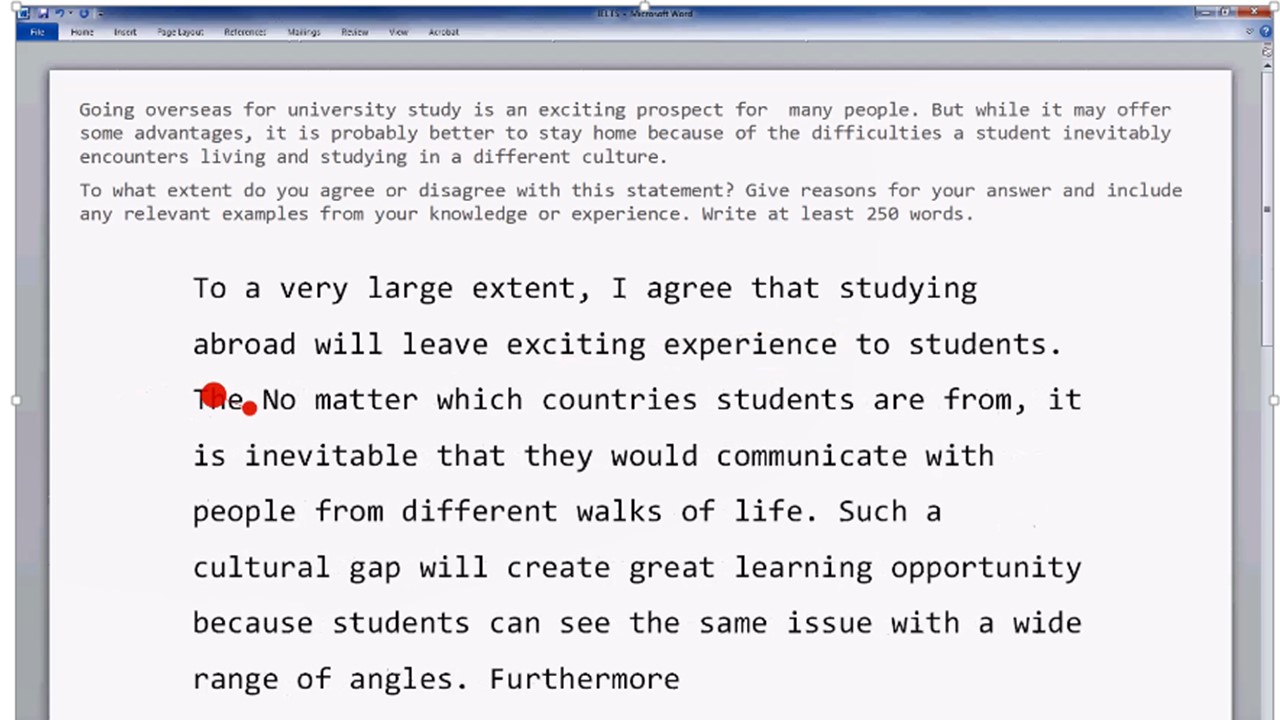 Investigating IELTS Academic Writing Task 2: Relationships between cognitive writing processes, text quality, and working memory
Investigating IELTS Academic Writing Task 2: Relationships between cognitive writing processes, text quality, and working memory
- Who? Marije Michel (Lancaster University, UK), Andrea Révész (Institute of Education, University of London, UK)
- What? This study took a closer look at test takers’ looking behaviour while performing on the IELTS writing task. The screen recordings of the eye movements were used to perform stimulated recall sessions. Eye tracking data was triangulated with information from key stroke logging and linked to writing products. This project was externally funded by the British Council as part of the 2014-15 IELTS Funded Research Programme.
- Research output
- Révész, A., Michel, M., & Lee, M.J. (2017, April). To what extent does working memory influence pausing and revision behaviours during L2 writing task performance? Paper presented at the Task-Based Language Teaching conference, Barcelona (Spain).
- Révész, A., Michel, M., & Lee, M.J. (2016). Investigating IELTS Academic Writing Task 2: Relationships between cognitive writing processes, text quality, and working memory. IELTS Research Reports Online Series 2017/3. IELTS Partners: British Council, Cambridge English Language Assessment and IDP: IELTS Australia.
- Révész, A., Michel, M., & Lee, M.J. (2016, Sep). To what extent do L2 revision behaviours relate to written text quality and working memory capacity? Paper presented at the Second Language Research Forum (SLRF), New York (USA).
- Révész, A., Michel, M., & Lee, M.J. (2016, July). Investigating the relationships between writing behaviors, text quality, and working memory using keystroke logging, eye-tracking and text analysis. Paper presented at the SIG Writing, Liverpool (UK).
- Révész, A., Michel, M., & Lee, M.J. (2016, July). An exploration of the relationships between writing behaviors and text quality using keystroke logging, eye-tracking and text analysis. Paper presented at the Language Testing Forum (LTF), Oxford (UK).
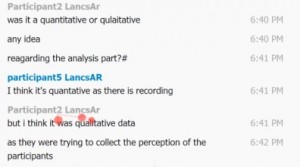 Second language use and development during text-chat. An eye tracking investigation into noticing, primed production and language learning during written computer mediated peer interaction
Second language use and development during text-chat. An eye tracking investigation into noticing, primed production and language learning during written computer mediated peer interaction
- Who? Marije Michel (Lancaster University, UK), Bryan Smith (Arizona State University, USA), Breffni O’Rourke (Trinity College Dublin, Ireland)
- What? In this study, eye tracking is used to investigate what second language learners look at while they are using text chat to discuss with each other on a collaborative writing task.
- Research output
- Michel, M., & O’Rourke, B. (2019). What drives alignment during text chat with a peer vs. a tutor? Insights from cued interviews and eye-tracking. System, 83, 50-63.
- Michel, M., & Smith, B. (2017). Measuring lexical alignment during L2 peer interaction via written synchronous computer-mediated communication – An eye-tracking study. In S. Gass, P. Spinner, & J. Behney (Eds.), Salience and SLA. Routledge.
- Michel, M. & Smith, B. (2017). Eye-tracking research in computer-mediated language learning. In S. Thorne and S. May (Ed.), Encyclopedia of Language and Education: Language and Technology. Heidelberg, Deutschland: Springer.
- Michel, M. (2016, Nov). Eye tracking text chat in a second language. Plenary given at the 3rd International Conference on Cognitive Research on Translation, Interpreting and Language Acquisition, Macao.
- Michel, M., & Smith, B. (2015, Sep). Eye movements during L2 written computer chat interaction. Paper presented at the Task-Based Language Teaching (TBLT) conference, Leuven (Belgium).
- Michel, M. (2015, June). Eye movements during L2 written computer chat interaction. Paper presented at the CRELLA/LU eye tracking research day, University of Bedfordshire (UK).
- Michel, M., Smith, B., & Mackey, M. (2014, Sep). Eye tracking L2 interaction during written synchronous computer-mediated communication – a qualitative exploration. Paper presented at the EuroSLA conference, York (UK).
- Michel, M., Smith, B., & Mackey, M. (2013, March). Primed production during SCMC: An eye tracking study. Paper presented at AAAL, Portland, Oregon (USA).
EyeAnt – a tool to measure eye-movements in dynamic contexts
- Who? Marije Michel (Lancaster University, UK), Laurence Anthony (Waseda University Tokyo, Japan)
- What? In this project, we are developing a tool that will allow measuring eye-movements in dynamic contexts, such as computer-mediated communication, webpage reading, or writing from a prompt.
- Research output
- Anthony, L., & Michel, M. (2016, March). Introducing EyeChat: A data collection tool for eye-tracking computer mediated communication. Talk given at the UCREL Research Seminar, Lancaster University (UK).
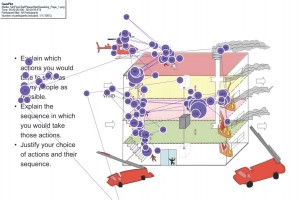 External validation of task complexity – using eye tracking, dual task methodology and subjective measures of task demands.
External validation of task complexity – using eye tracking, dual task methodology and subjective measures of task demands.
- Who? Marije Michel (Lancaster University, UK), Andrea Révész (Institute of Education, University of London, UK), Roger Gilabert (Universidad de Barcelona, Spain)
- What? This project investigated whether eye movements can be a good means to measure cognitive processing and mental effort during complex communicative speaking tasks.
- Research output
- Michel, M., Révész, A., & Gilabert, R. (2014, Aug). Eye movement prompts in stimulated recall: tapping cognitive processes based on audio vs. visual stimuli. Paper presented at AILA, Brisbane (Australia).
- Michel, M., Révész, A., & Gilabert, R. (2013, Oct). The effects of task complexity manipulations on cognitive processes: What do we learn from stimulated recall and eye-tracking data? Invited colloquium paper at the 5th TBLT conference, Banff (Canada).
- Michel, M. (2013, Sep). Eye-tracking and the independent measurement of task complexity: Evidence from German EFL learners. Invited talk at GRAL, Barcelona (Spain).
To learn about our students’ projects involving eye-tracking, please click here.